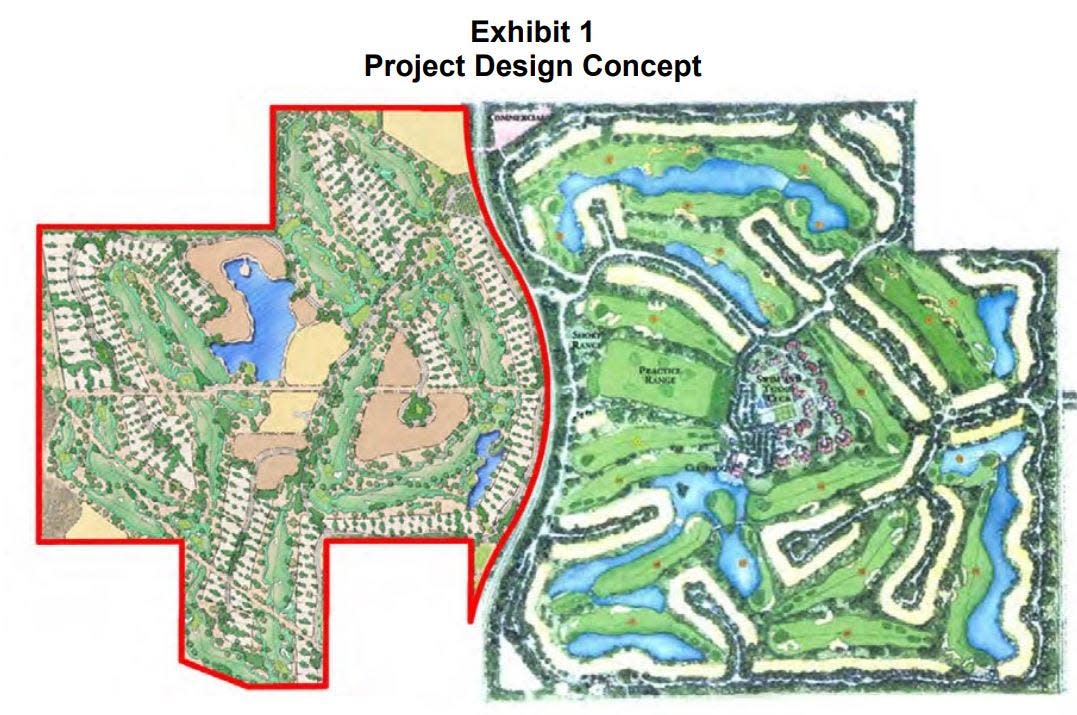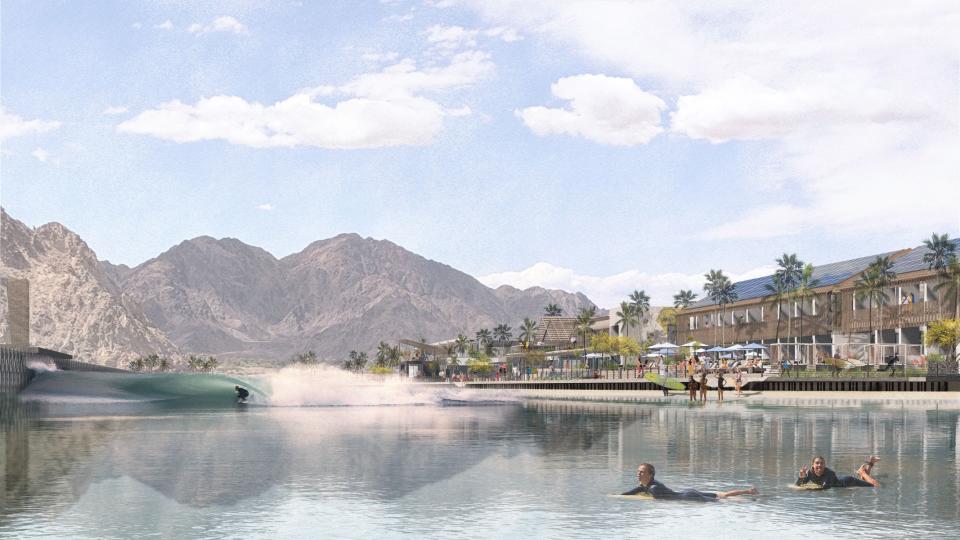Coral Mountain project in La Quinta gains council approval, minus controversial wave basin

Over a year after the La Quinta City Council rejected a large-scale development at the base of Coral Mountain, a revised plan for the 387-acre parcel — this time, without the hotly debated wave basin that drew strong opposition from nearby residents — gained approval from the council this week.
The proposed development, which will have 750 homes, an 18-hole golf course, a 10-acre recreation lake and 60,000 square feet of commercial space, was advanced by the city’s planning commission in January. Beyond a few layout changes, much of the revised proposal is consistent with existing zoning designations for the site at the southwest corner of Avenue 58 and Madison Street.
The council approved the development agreement for the Club at Coral Mountain by a 4-1 vote Tuesday night, with Councilmember Kathleen Fitzpatrick voting no due to concerns about the lack of any cap on the number of short-term rentals. The city’s planning commission had also recommended consideration of a cap, but others on the council thought it wasn’t necessary given the city’s rental trends.
The overall plans for the site were reworked after the city council unanimously rejected the prior development in September 2022, citing concerns over major zoning changes that would have been required for the wave basin and a proposed hotel. The vote came after opposition from neighboring communities, who criticized its potential impacts on traffic, noise and light pollution, as well as its water usage.
More: La Quinta City Council unanimously rejects Coral Mountain Resort project, wave pool
That original proposal was first announced in 2020 by Meriwether Companies and Big Sky Wave Developments, who teamed up as CM Wave Development LLC to buy the land. At the time, project developers touted bringing “the largest, rideable open-barrel, human-made wave in the world” to La Quinta.

While the prior plan drew strong pushback, the proposal before the council Tuesday was not as hotly opposed, though some residents were concerned with short-term rentals being allowed under the project, as well as how the project might impact the surrounding desert ecosystem. The land sits just west of the Andalusia County Club, and the two parcels are part of the same specific plan.
As part of its vote Tuesday, the council also agreed to incorporate a protection plan for bighorn sheep, including an eight-foot fence along the mountain’s slope and a 50-foot buffer for vegetation along the western and southern boundaries of the Coral Mountain tract map. While the main development agreement was opposed by Fitzpatrick, the project’s remaining technical changes and environmental evaluations gained unanimous council approval.
What's in the project?
John Gamlin, president of CM Wave Development, told the council Tuesday that despite having a high-end course, the community will not be “golf-centric,” but rather one that focuses holistically on healthy lifestyles. Its central area will feature a sports clubhouse next to a 10-acre lake for activities.
“Coral Mountain was always intended to be a place that nurtures the spirit and wellbeing ... expressed through an authentic, active lifestyle and experiences with friends and family,” Gamlin said.
Gamlin added the course “will not be your grandfather’s golf course,” as the development team is working with David McLay Kidd, a Scottish golf course architect who’s worked on many well-regarded courses, on its layout and design. His team is also designing some walking and biking trails throughout the community and the course connecting to paths around Coral Mountain.

For the 10-acre lake, Gamlin said activities such as paddleboarding, kayaking and the use of smaller electric boats could be options, but he said gasoline-powered motorboats were not envisioned for the site. The facilities will be private for only residents and their guests.
Gamlin has also noted the lake will use non-potable water while acting as an irrigation facility to store water for nearby landscaping in the development.
Estimates from the Coachella Valley Water District, whose board approved the water usage plans last fall, show the lake would use 70.26 acre-feet per year, while the irrigated turf on the golf course will require 436.46 acre-feet per year. An acre-foot is about 326,000 gallons, or enough to serve at least two households per year.
In total, the new project’s projected demand for water is about 27% higher than the previous proposal, according to CVWD estimates.
The development team is still studying the possibilities for the 60,000-square-foot commercial space, which is planned for the property's northeast corner, but Gamlin mentioned "an agrarian, farm-to-table" concept that would offer a place for residents of Coral Mountain and surrounding areas to hang out and socialize.
With the council’s approval, the project could see construction begin in the first quarter of 2025, with the golf course potentially opening in mid-2026 and the first residential phase in 2026 or 2027. The project’s full buildout is expected to take seven to 10 years once construction gets underway.
What residents said
While the meeting did not draw as many public comments as the 2022 hearing for the wave park, several residents spoke Tuesday on a handful of topics, including the project’s allowance of short-term vacation rentals.
Resident Robert Lasser said he views the project not as a residential golf community, but instead as "a tourist-oriented resort-entertainment recreational destination venue to be comprised exclusively of up to 750 luxurious short-term vacation rentals disguised and presented to the community and city council as just another golf course community.”
“This proposed project will bring crowds, traffic and noise on what could be an everyday occurrence to an area that is now a quiet residential area, with no noise, no crowds, no traffic, no commercialism and no light pollution,” Lasser said.
Another resident, Sheila Warren, said she understood something would be built on the land and that short-term vacation rentals are allowed under its existing specific plan. But she pushed the council to get some commitments from the developer, such as no motorized boats on the lake, no shuttle-bussing or parking along the surrounding public streets and a 20% cap on the number of short-term rentals allowed in the development.
Guillermo Casillas, who lives next to the property, said he remains in opposition to the project, noting the parcel has long been sacred land for the local Cahuilla native tribes. However, he said he's glad local tribal groups will now be involved with the construction process. He also wanted to see vehicle access onto the property via Avenue 60 limited to only residents.
Others worried about the project’s impact on surrounding habitats. In a letter this week, the local Sierra Club chapter’s chairperson, Joan Taylor, asked the council to continue the hearing, raising concerns about “the many scores of deaths of endangered bighorn sheep in La Quinta caused by the attractive and deadly nuisance of golf courses.” (In a separate letter, the local Bighorn Institute said it has documented 60 “urban-related” bighorn sheep deaths on or near four La Quinta golf courses since 2012.)
Taylor also pushed for more input from state and federal wildlife agencies, saying the city’s outreach for its environmental assessments was inadequate. However, Nicole Criste, a planner with Terra Nova Planning & Research who worked on the plans, said the city and the developer worked with the California Department of Fish and Wildlife to develop protections for the sheep populations, including the eight-foot fence and buffer area.
What the council said
The council largely supported the project, though its five members discussed several details of the proposal before their vote. While the city implemented a ban on new short-term rental permits in 2021, there are exceptions for particular tourist-commercial zones — as well as for residential projects with a development agreement that allows them, such as Coral Mountain’s.
Gamlin told the council that his team didn’t see a need for a short-term rental cap, noting the decision could be left to the community’s HOA, just as the Andalusia HOA decided to limit its short-term rentals despite its specific plan allowing for them.
He also described the city’s rental trends as “self-regulating,” noting the city’s roughly 1,200 active permits comprise only a small percentage of the total homes in La Quinta.
“We know that from experience in these communities that a fraction of what's eligible rents,” Gamlin said. “At any given time, only a fraction of that fraction are actually going to be rented, because they're going to be used by the people that own those homes."
He added that anyone buying into the community will get clear sales disclosures letting them know some houses could be short-term rentals. And the community will have on-site property management 24 hours a day who can respond to any issues, including with a home that's being rented out.
Councilmember Steve Sanchez agreed that the trends would be self-regulating and said a cap would be “arbitrary based on no data.” He also noted the city hasn’t placed such STVR restrictions within other development agreements for new projects.
Councilmember Deborah McGarrey noted that with the Coral Mountain development, potential buyers “are very much aware of what they’re getting into,” rather than a scenario in which rentals unexpectedly emerge next door in existing neighborhoods.
Fitzpatrick, the lone vote against the development agreement, said she was willing to find “some kind of balance” for short-term rentals in the Coral Mountain project, but said she was uncomfortable with 100% of the planned homes being allowed as short-term rentals. She said she preferred a percentage cap in the range of 25% to 30%.
“I wouldn't go so far as to say I feel that it's truly looking at this development as a commercial development, but I would say it adds a feeling that is not compatible necessarily with some of the other communities that are right there,” Fitzpatrick said, noting both Trilogy and Andalusia don’t allow such rentals.
But Mayor Pro Tem John Peña agreed with the rest of the council, saying to “let the homeowners decide what they want to do” with the community’s rental rules.
“I think that we've seen this project go through a lot of review, and I think that we're getting a good project as a result of it,” Peña said.
Tom Coulter covers the cities of Palm Desert, La Quinta, Rancho Mirage and Indian Wells. Reach him at thomas.coulter@desertsun.com.
This article originally appeared on Palm Springs Desert Sun: La Quinta OKs Coral Mountain project, minus controversial wave basin

